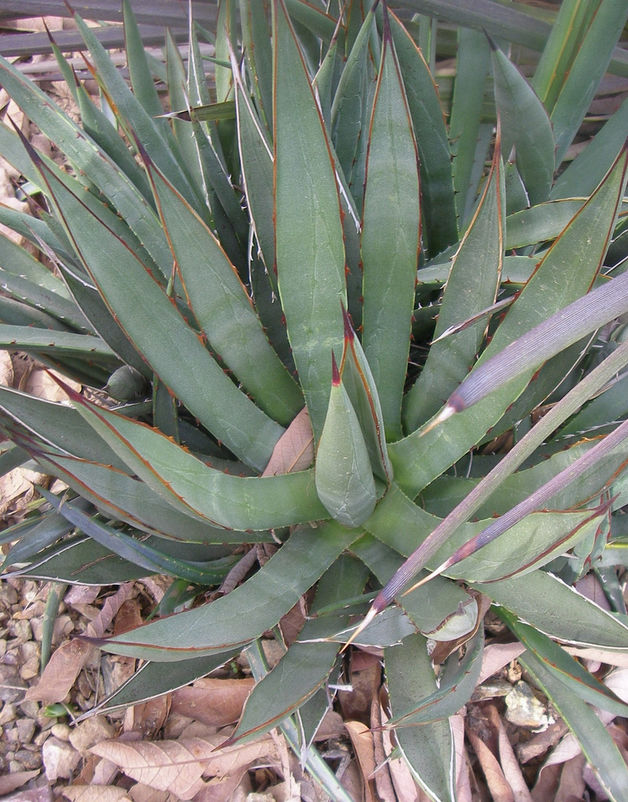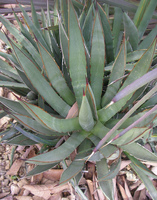
|
|
|
|
Family: Asparagaceae
arizona agave, more...Arizona century plant
[Agave arizonica Gentry & J.H. Weber] |
Plants acaulescent, sparingly suckering; rosettes solitary or sparingly cespitose, 2-3.5 × 3-4 dm. Leaves spreading, 13-31 × 2-3.2 cm; blade dark green, without bud-prints, linear-lanceolate, rigid, adaxially slightly concave toward apex, abaxially convex toward base; margins straight, non-filiferous, conspicuously armed, horny from below mid-blade to apical spine, teeth single, (1-)2-5 mm, 1-3(-5) cm apart; apical spine dark brown to gray, subulate, 1-2.5 cm. Scape 2.5-4 m. Inflorescences subspicate to racemose-paniculate, openly flowered; bracts caducous, triangular, 8-12 cm; lateral branches 30-40, comprising distal 1/4-1/3 of inflorescence, 4 cm or shorter. Flowers 10-20 per cluster, erect, cylindric-urceolate, 2.5-3.5 cm; perianth pale yellow, sometimes fused with red, tube campanulate, 3.5-7.5 × 8-9 mm, limb lobes not connivent, erect to ascending, subequal, 8-11 mm; stamens long-exserted; filaments inserted 4 mm above base of perianth tube, erect, light yellow, 1.6-3 cm; anthers pale yellow to yellow, 7-11 mm; ovary 0.8-1.5 cm, neck constricted, 4-6 mm. Capsules short-pedicellate, ellipsoid to obovoid, 1.5-2.2 cm, apex beaked. Seeds 3-4.5 mm. 2n = 60. Flowering mid spring--early summer. Rocky slopes in chaparral and juniper-dominated grasslands; of conservation concern; 900--1800 m; Ariz. Agave × arizonica is a hybrid population involving A. chrysantha and A. toumeyana var. bella. Only about 60 clones are known. Plant: perennial scapose herb; Rosettes single or sparingly caespitose, globose, ca. 20-35 cm high, 30-40 cm broad Leaves: several, 13-31 cm long, 2-3.2 cm wide, broadest at or just above middle, linear-lanceolate, acuminate, spreading, rigid, dark green, shallowly concave towards apex, thickly convex at base, the margins straight, with a broad red-brown to gray border, this continuous nearly to base; teeth variable, when present the larger ones 2-5 mm long; interstitial teeth absent; terminal spine 1-2.5 cm long, subulate, shallowly grooved above, dark brown, aging gray, decurrent with border INFLORESCENCE: with scape 2.5-4 m tall, subspicate to narrowly racemose-paniculate, of 30-40 short lateral branchlets in upper 1/4 of flowering stalk, the stalk slender, green Flowers: 25-32 mm long, durable, cylindric-urceolate, short-pedicellate, in close-set clusters of 10-20; tepals unequal, 8-11 mm long, 2.5-3 mm wide, somewhat overlapping and clasping the filaments but not connivent, erect to ascending, ovate-lanceolate with blunt tips, wilting soon after anthesis, yellow; filaments 16-30 mm long, inserted equally 4 mm above base of tube, yellow, the anthers 7-11 mm long, light yellow; ovary 10-15 mm long, with constricted neck 4-6 mm long, lime-green, the style light yellow; floral tube 3.5-7.5 mm long, 8-9 mm broad, shallow, broadly ascending, light lime-green Fruit: a loculicidal capsule, oblong to globose, 15-22 mm long, 8-13 mm broad, elliptic to obovoid, strongly beaked; SEEDS black, 4.5 mm long, 3.3 mm wide Misc: Open rocky slopes in chaparral or juniper grassland; 1100-1750 m (3600-5800 ft); May-Jul REFERENCES: Hodgson, Wendy. 1999. Agavaceae. Ariz. - Nev. Acad. Sci. 32(1). |
This project was made possible in part by the Institute of Museum and Library Services [MG-70-19-0057-19].
Powered by Symbiota




